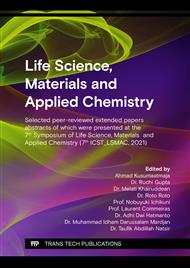[1]
M. Arbyn, E. Weiderpass, B. Laia, S. Silvia de Sanjose, S. Mona, F. Jacques, B. Freddie, Estimates of incidence and mortality of cervical cancer in 2018: a worldwide analysis, Lancet Glob. Health. 8 (2019), E191-E203.
DOI: 10.1016/s2214-109x(19)30482-6
Google Scholar
[2]
B. Damodaran, B. Prabhu, G. Vinothkumar, C.N. Prashantha, S.R. Pulakuntla, G.M. Sankolli, P. Venkataraman, RNA Sequencing-based Transcriptomic profiles of HeLa, MCF-7 and A549 cancer cell line treated with Calotropis gigantea leaf extracts, Gene Rep. 23 (2021), 1-10.
DOI: 10.1016/j.genrep.2021.101119
Google Scholar
[3]
C.E.A. de Souza, A. Do Rocio Andrade Pires, C.R Cardoso, R.M. Carlos, S.M.S.C. Cadena, A. Acco, Anineoplastic activity of a novel ruthenium complex against human hepatocellular carcinoma (HepG2) and human cervical adenocarcinoma (HeLa) cells, Heliyon. 6 (2020), 1-9.
DOI: 10.1016/j.heliyon.2020.e03862
Google Scholar
[4]
S.Gharavian, N. Hosseini-Giv, L. Rafat-Motavalli, S. Abdollahi, A.R. Bahrami, H. Miri-Hakimabad, M.M. Matin, Assessing the relative biological effectiveness of high-dose rate 60Co brachytherapy alone and in combination with cisplatin treatment on a cervical cancer line (HeLa), Radiat. Phys. Chem. 184 (2021), 1-6.
DOI: 10.1016/j.radphyschem.2021.109465
Google Scholar
[5]
N. Kleczewska, P. Ruszkowski, A. Singh, R. Trznadel, L. Celewiz, Synthesis and anticancer activity of 3'-[4-fluoroaryl-(1,2,3-triazol-1-yl)]-3'-deoxythymidine analogs and their phosphoramidates, Nucleosides, Nucleotides & Nucleic Acids. (2019) 1-36.
DOI: 10.1080/15257770.2019.1594282
Google Scholar
[6]
M. Alloui, S. Belaidi, H. Othmani, J. Nejm-Eddine. H Majdi, Imidazole derivatives as angiotensin II AT1 receptor blockers: Benchmarks, drug-like calculations, and quantitative structure-activity relationship modeling, Chem. Phys. Lett. 696 (2018), 70-78.
DOI: 10.1016/j.cplett.2018.02.048
Google Scholar
[7]
R.O. Oyewole, A.K. Oyebamiji, B. Semire, Theoretical calculations of molecular descriptors for anticancer activities of 1,2,3-triazole-pyrimidine derivates against gastric cancer cell line (MGC-803): DFT, QSAR and docking approaches, Heliyon. 6 (2020), 1-13.
DOI: 10.1016/j.heliyon.2020.e03926
Google Scholar
[8]
M. Yahyavi, F. Badalkhani-Khamseh, N.I. Hadipour, Adsorption behavior of pristine, Al-, Si-doped carbon nanotubes upon 5-fluorouracil, Chem. Phys. Lett. 750 (2020), 1-10.
DOI: 10.1016/j.cplett.2020.137492
Google Scholar
[9]
L.A. Anthony, D. Rajaraman, M. Shanmugam, K, Krishnasamy, Synthesis, spectral techniques, X-ray crystal structure, DFT method, Hirshfeld surface analysis and molecular docking studies of 1-(furan-2-yl)methyl)-4,5-diphenyl-2-(p-tolyl)-1H-imidazole, Chem. Data Collect. 28 (2020), 1-18.
DOI: 10.1016/j.cdc.2020.100421
Google Scholar
[10]
E. Yuanita, Sudirman, N.K.T. Dharmayani, M. Ulfa, J. Syahri, Quantitative structure-activity relationship (QSAR) and molecular docking of xanthone derivatives as anti-tuberculosis agents, J. Clin. Tuberc. Other Mycobact. Dis. 21 (2020), 1-8.
DOI: 10.1016/j.jctube.2020.100203
Google Scholar
[11]
Y. Hao, G. Sun, T. Fan, X. Sun, Y. Liu, N. Zhang, L. Zhao, R. Zhong, Y. Peng, Prediction on the mutagenicity of nitroaromatic compounds using quantum chemistry descriptors based QSAR and machine learning derived classification methods, Ecotoxicol. Environ. Saf. 186 (2019), 1-11.
DOI: 10.1016/j.ecoenv.2019.109822
Google Scholar
[12]
A.M. Anter, Y.S. Mooemen, A. Darwish, A.E. Hassanien, Multi-target QSAR modelling of chemo-genomic data analysis based on extreme learning machine, Knowl.-Based Syst. 188 (2020), 1-16.
DOI: 10.1016/j.knosys.2019.104977
Google Scholar
[13]
M.M. Al Mogren, E. Zerroug, S. Belaidi, A. BenAmor, S.D.A. Al Harbi, Molecular structure, drug likeness and QSAR modeling of 1,2-diazole derivatives as inhibitors of enoyl-acyl- carrier protein reductase, J. King Saud Univ. Sci. 32 (2020), 2301-2310.
DOI: 10.1016/j.jksus.2020.03.007
Google Scholar
[14]
R. Abdizadeh, F. Hadizadeh, T. Abdizadeh, QSAR analysis of coumarin-based benzamides as histone deacetylase inhibitors using CoMFA, CoMSIA and HQSAR methods, J. Mol. Graph. 1199 (2020), 1-22.
DOI: 10.1016/j.molstruc.2019.126961
Google Scholar
[15]
X. Zhang, J. Mao, K. Koike, J. Wang, Improved 3D-QSAR prediction by multiple-conformational alignment: A case study on PTP1B inhibitors, Comput. Biol. Chem. 83 (2019), 1-9.
DOI: 10.1016/j.compbiolchem.2019.107134
Google Scholar
[16]
V.P. Zambre, R.B. Patil, J.N. Sangshetti, S.D. Sawant, Comprehensive QSAR studies reveal structural insights inti the NR2B subtype selective benzapine derivatives as N-Methyl-D-Aspartate receptor antagonists, J. Mol. Struct. 1197 (2019), 617-627.
DOI: 10.1016/j.molstruc.2019.07.068
Google Scholar
[17]
Y. David C., A practical guide for applying techniques to real-world problems, A JOHN WILEY & SONS, INC., PUBLICATION, New York, (2001).
Google Scholar
[18]
L. Errol G., Introduction to the theory and application of molecular and quantum mechanics (2nd Eds.), Springer, New York, (2011).
Google Scholar
[19]
H.B. Schlegel, Geometry optimization, Adv. Rev. 1 (2011), 790-809.
Google Scholar
[20]
S. Baday, Optimization of CHARMM force field parameters of a prostate cancer drug enzalutamide, J. Mol. Graph. 96 (2020), 1-9.
DOI: 10.1016/j.jmgm.2020.107541
Google Scholar
[21]
R. Kasmi, E. Hadaji, O. Chedadi, A. El Aissouq, M. Bouachrine, A. Ouammou, 2D-QSAR and docking study of a series of coumarin derivatives as inhibitors of CDK (anticancer activity) with an application of the molecular docking method, Heliyon. 6 (2020), 1-11.
DOI: 10.1016/j.heliyon.2020.e04514
Google Scholar
[22]
I. Tahir, N.F. Fatimah, R. Armunanto, 2012, Analisis hubungan kuantitatif struktur dan aktivitas antitoksoplasma senyawa analog kuinolon menggunakan deskriptor teoritik, J. Sains dan Terap. Kim. 6 (2012), 139-153.
DOI: 10.20527/jstk.v1i1.4986
Google Scholar
[23]
K. Roy, S. Kar, R.N. Das, A primer on QSAR/QSPR modeling, Springer, (2014).
Google Scholar
[24]
R. Qi, Y. Pan, J. Cao, Z. Jia, J. Jiang, The cytotoxicity of nanomaterials: Modeling multiple human cells uptake of functionalized magneto-fluorescent nanoparticles via nano-QSAR, Chemosphere. 249 (2020), 1-9.
DOI: 10.1016/j.chemosphere.2020.126175
Google Scholar
[25]
S.S. Chourasia, S.K. Kharkate, T.D. Kose, Synthesis, QSAR modeling and antimicrobial studies of 1-(4-phenyl) subtituted tetrahydro isoquinoline derivatives, Mater. Today. 29 (2020), 956-963.
DOI: 10.1016/j.matpr.2020.05.673
Google Scholar
[26]
I. Tahir, M. Mudasir, I. Yulistia, M. Mustofa, Quantitative structure-activity relationship analysis (QSAR) of vincadifformine analogues as the antiplasmodial compounds of the chloroquinosensible strain, Indo. J. Chem. 5 (2005), 255-260.
DOI: 10.22146/ijc.21800
Google Scholar
[27]
M.A. Abbasi, H. Raza, Aziz-ur-Rehman, S.Z. Siddiqui, S.A.A. Shah, M. Hassan, S.-Y. Seo, Synthesis of novel N-(1,3-thiazol-2-yl)benzamide clubbed oxadiazole scaffolds: Urease inhibition, Lipinski rule, and molecular docing analyses, Bioorg. Chem. 83 (2019), 63-75.
DOI: 10.1016/j.bioorg.2018.10.018
Google Scholar
[28]
C.M. Chagas, S. Moss, L. Alisaraie, Drug metabolites and their effects on the development of adverse reactions: Revisiting Lipinski's Rule of Five, Int. J. Pharm. 549 (2018), 133-149.
DOI: 10.1016/j.ijpharm.2018.07.046
Google Scholar



